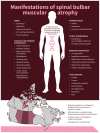Best practice recommendations for the clinical care of spinal bulbar muscular atrophy
- PMID: 40983380
- PMCID: PMC12479135
- DOI: 10.1503/cmaj.250180
Best practice recommendations for the clinical care of spinal bulbar muscular atrophy
Abstract
Background: Although rare in the general population, spinal bulbar muscular atrophy (SBMA) is an X-linked recessive neuromuscular condition that is highly prevalent in people identifying as First Nations and Métis in western Canada. The aim of this guideline is to improve and standardize care of SBMA, and to increase awareness of the condition.
Methods: Our interdisciplinary working group conducted a needs assessment survey to aid in the development of guideline topic questions, followed by a literature search, evidence review, and external review by health practitioners and people with lived experience. We followed the ADAPTE framework to evaluate the only pre-existing SBMA guideline (2020 French national protocol) and the 2020 Canadian amyotrophic lateral sclerosis guideline for appropriateness of adaptation. Our process adhered to the Appraisal of Guidelines for Research and Evaluation (AGREE II) tool; used the Grading of Recommendations, Assessment, Development, and Evaluation (GRADE) approach; and followed the Guidelines International Network-McMaster Guideline Development Checklist. Indigenous community engagement was led by the Pewaseskwan Indigenous Research Group, who participated in the development of the guideline.
Recommendations: We developed 41 recommendations to address the continuum of care in SBMA, including diagnosis; multidisciplinary teams; management of limb and bulbar symptoms, respiratory and cardiac complications, and multisystem symptoms; female carriers; emotional supports; and considerations for Indigenous people. Spinal bulbar muscular atrophy is best managed by multidisciplinary teams that can address both its motor and nonmotor manifestations, including cardiac involvement, sensory symptoms, and metabolic dysfunction. Concerns for female carriers may include symptom management and genetic counselling. Providers should ensure culturally appropriate care for Indigenous people.
Interpretation: In this guideline, we provide health care professionals with a culturally responsive standard of care for SBMA, and hope this will translate into improved quality of life for people affected by SBMA.
© 2025 CMA Impact Inc. or its licensors.
Conflict of interest statement
Competing interests:: Kerri Schellenberg, Malcolm King, and Alexandra King report receiving grants from the Saskatchewan Health Research Foundation (as principal applicant and investigator) and matched funding from Muscular Dystrophy Canada, in support of the present manuscript. Dr. Schellenberg has also received grants from Muscular Dystrophy Canada (Translational Science Seed Grant), the Canadian Institutes of Health Research (CIHR; a Project Grant and a Team Grant), and the New Frontiers in Research Fund, all outside the submitted work. Malcolm King and Alexandra King report receiving grants from Muscular Dystrophy Canada and CIHR (Project Grant), outside the submitted work. Alexandra King has also received a grant from New Frontiers in Research Fund–Exploration, outside the submitted work. Andrea Lavoie reports receiving honoraria from AstraZeneca, Bayer, BMS, Novartis, NovoNordisk, HLS, Servier, Pfizer, Kye, and GSK. Dr. Lavoie has also participated on advisory boards for Pfizer, NovoNordisk, AstraZeneca, and HLS, and has served as a co-chair of the Prairie Cardiac Foundation (unpaid). Colleen O’Connell reports holding an unpaid role as the co-lead of the Clinical Outcomes pillar for the Neuromuscular Disease for Canada Network. Jodi Warman-Chardon reports holding an unpaid volunteer role on the board of directors for Muscular Dystrophy Canada. Gerald Pfeffer reports receiving grants from Kennedy’s Disease Association, Muscular Dystrophy Canada, the New Frontiers in Research Fund Explorations Program, and the CIHR Project Program (all paid to institution and outside the submitted work). Dr. Pfeffer also serves on the medical or scientific advisory boards for Muscular Dystrophy Canada, ALS Canada, Ataxia Canada, and Cure VCP Inc. (all unpaid or volunteer roles). No other competing interests were declared.
Figures
References
-
- Breza M, Koutsis G. Kennedy’s disease (spinal and bulbar muscular atrophy): a clinically oriented review of a rare disease. J Neurol 2019;266:565–73. - PubMed
-
- Atsuta N, Watanabe H, Ito M, et al. Natural history of spinal and bulbar muscular atrophy (SBMA): a study of 223 Japanese patients. Brain 2006;129:1446–55. - PubMed
Publication types
MeSH terms
LinkOut - more resources
Full Text Sources

